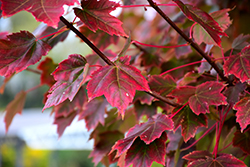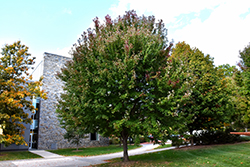Brandywine Red Maple
Acer rubrum 'Brandywine'
Height: 30 feet
Spread: 15 feet
Sunlight:
![]()
![]()
Hardiness Zone: 4
Other Names: Swamp Maple, Soft Maple
Description:
A stunning seedless male tree with an oval habit, upright form makes it ideal for smaller home landscapes; subtle red flowers cover the bare branches in spring, spectacular long lasting purplish-red fall color
Ornamental Features
Brandywine Red Maple is primarily valued in the landscape for its decidedly oval form. It has rich green deciduous foliage. The lobed leaves turn an outstanding red in the fall. The furrowed gray bark and brick red branches add an interesting dimension to the landscape.
Landscape Attributes
Brandywine Red Maple is a dense deciduous tree with a shapely oval form. Its average texture blends into the landscape, but can be balanced by one or two finer or coarser trees or shrubs for an effective composition.
This is a relatively low maintenance tree, and should only be pruned in summer after the leaves have fully developed, as it may 'bleed' sap if pruned in late winter or early spring. It has no significant negative characteristics.
Brandywine Red Maple is recommended for the following landscape applications;
- Accent
- Shade
- Vertical Accent
Planting & Growing
Brandywine Red Maple will grow to be about 30 feet tall at maturity, with a spread of 15 feet. It has a low canopy with a typical clearance of 4 feet from the ground, and should not be planted underneath power lines. It grows at a medium rate, and under ideal conditions can be expected to live for 70 years or more.
This tree does best in full sun to partial shade. It prefers to grow in average to moist conditions, and shouldn't be allowed to dry out. It is not particular as to soil type, but has a definite preference for acidic soils, and is subject to chlorosis (yellowing) of the foliage in alkaline soils. It is somewhat tolerant of urban pollution. This is a selection of a native North American species.


